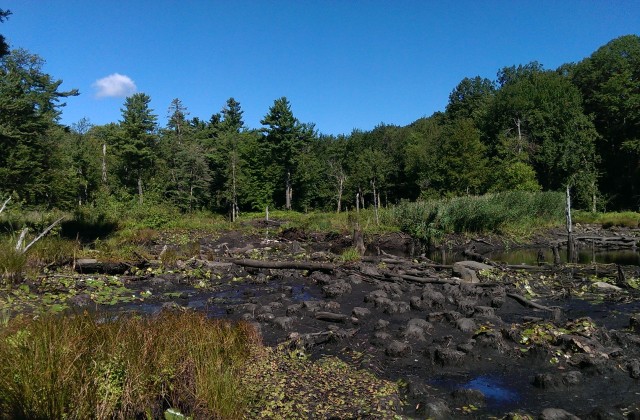Heavy Rainfall Breaks Beaver Dam
A Road Is Damaged And A Pond Ecosystem Lost:
by John Anderson
Early on the stormy night of August 10th a catastrophic event occurred: after nearly six inches of rainfall, a beaver dam impounding 20 acres of water in Aton Forest broke. One person living nearby heard what she thought was a falling tree during the storm. The breach of this large upper dam led to the breach of a smaller, lower dam and the force of more than a million gallons of water swelled behind and then over the stream crossing at South Sandisfield Road. By morning this section of road had washed away leaving a 12-foot gap and a six-foot-deep channel, scoured to a rocky basement. On discovering the damage, a nearby resident tried to contact the Norfolk town hall but reached only the message service. Shortly afterwards, a group of six motorcycles came to a sudden stop at the edge of the abyss. The resident then called the State Police and quickly the town put up signs and a barricade. By the afternoon of August 14th, the road had been repaired with new concrete and stone retaining walls.
Thousands of animals living in the beaver pond lost their habitat. Small minnows were found stranded and dead in the newly exposed mud the next day. Other fish, as well as turtles and beavers, were likely sucked down this drain, carried along with logs and stones, crashing through the streamside forest, finally to settle dead or alive in Benedict Pond. The full impact of this and another sediment plume in Benedict Pond from an earlier washout is not yet known. What remains of the old beaver pond is knee-deep mud, much of it covered with once floating pond-lilies and watershield.
The loss of this pond makes us realize what diversity beaver have brought to our environment. Beaver were by and large extirpated from Connecticut in the 19th century, due to trapping and loss of habitat. As farmlands were abandoned, the forests returned, and so did the beaver. In the past, this particular wetland had been drained and used for agriculture; then, untouched by man or beaver, the site became a forested swamp. Finally, a new beaver impoundment created habitat for dozens and dozens of new species, ones dependent upon open water, sunlight, marsh, and large dead trees.
Beaver have maintained this pond for over forty years. Past storms have seen over six inches of water top this dam without ill effect. There have been a few breaches over the years, but the beaver always managed to repair and maintain their dams and lodges. The road has also washed out a few times, most recently in 2010. That year the beaver suddenly disappeared from the pond. They may have been trapped or died mysteriously or simply left. Then in 2012 the beaver returned, though they were not seen as often as before. It is likely this hiatus allowed the dam to rot and leak, resulting in a weak spot that caused the recent breach.
The culvert installed at South Sandisfield Road can carry normal flows, but the extraordinary rainfalls we have experienced lately tax its capacity . The town has installed a grate on the upstream side of the four-foot-diameter culvert to keep the beaver and floating deadwood from clogging it. Regular maintenance of this is required, otherwise the clogged grate and the roadbed become another dam. This stream crossing is similar to others in town, many of which impede the movement of wild animals or require them to make hazardous road crossings.
Recently the Norfolk Conservation Commission and Aton Forest co-sponsored two public events to highlight roadside ecology and safe wildlife corridors. The follow-up has been discussions regarding what do as a town to improve our roads and roadsides for wildlife. A bridge or wide arched culvert would have been an ideal solution for improving the South Sandisfield Road site, but in this emergency the town did not have materials or time to do this. A strategic plan is needed for replacing inadequate culverts and improving these crossings. With corrective action, our unnatural impact on natural processes can be prevented or mitigated.
In the meantime, the beaver have already begun to rebuild their dam at Aton Forest, though it is likely to be lower. In the past, marsh and swamp covered much of the site. Old dead tussocks and long-drowned tree stumps—still showing beaver cuts—have now been exposed. New open marsh and forested swamp may develop on the margins until the pond reaches its maximum size once again. Such changes are only natural.
John Anderson is Executive Director of Aton Forest, Inc., an ecological research station and natural preserve in northeast Norfolk. He is also a member of the Norfolk Conservation Commission.

